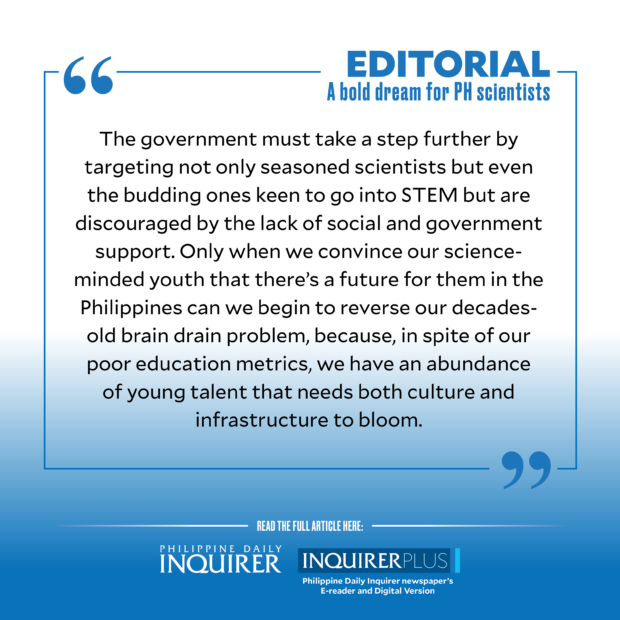Before the advent of the internet, an entire generation of Filipinos firmly believed that our kababayan Agapito Flores was the inventor of the fluorescent lamp. However, this is nothing more than a myth. The credit for inventing the fluorescent lamp actually goes to the scientists who developed the prototype introduced by General Electric in the 1930s. It is now clear to us, in retrospect, how absurd that claim was. But back then, we were easily swayed by the idea that “fluorescent” came from “Flores,” especially because it was mentioned in some textbooks. Those were simpler times when a false story could easily transform into a popular legend due to the lack of fact-checking tools.
Today, it would be much harder to convince the public that a Filipino could achieve such a monumental feat or even entertain the idea that one of us could one day receive a Nobel Prize in the sciences. This week, the winners of the Nobel Prizes were announced, and while a Filipino Nobel laureate in physics, medicine, or chemistry may seem impossible, skeptics would say that our only chance lies in the literature and peace prizes, with journalist Maria Ressa already securing the latter in 2021. However, as a nation, we still dare to dream.
As the American scholar John Dewey once wrote, “Every great advance in science has issued from a new audacity of imagination.” While it may be audacious to envision a Philippines with world-class institutions pursuing groundbreaking knowledge, that is precisely what fuels our hopes for the “Balik Scientist Program” (BSP), a project initiated by the Department of Science and Technology (DOST) to entice Filipino scientists working abroad to come back home. Under Republic Act No. 11035, returning scientists enjoy enticing incentives such as round-trip airfare, exemption from travel taxes and import duties, free medical insurance, and relocation benefits including job opportunities for their spouses and a housing allowance, among others.
Thanks to these perks, 44 scientists have already returned under the BSP since last year, bringing the total number of returnees to 631 since 1975, according to the DOST. While these numbers may seem modest, with time, energy, and sufficient resources, even the tiniest ripple can turn into a massive wave. But to apply the scientific method, we must first identify and address the challenges facing our knowledge sector. And there are indeed many.
For instance, in the 2022 Global Innovation Index, the Philippines slid down eight spots to 59th out of 132 countries. The country has fewer than 174 full-time researchers per million people, ranking 84th, while Singapore boasts 7,287 researchers per million. Our gross expenditure on research and development is a mere 0.32 percent, falling well below the global average of 2 percent. Additionally, education in the science, technology, engineering, and mathematics (STEM) field is another colossal obstacle. The Philippines consistently performs poorly in international assessments such as the 2018 Programme for International Student Assessment, the 2019 Trends in International Mathematics and Science Study, and the 2019 Southeast Asia Primary Learning Metrics.
Overcoming these barriers may require more than one administration, but we are encouraged by the support shown so far by President Marcos, who himself has been referred to as a “frustrated scientist” and has advocated for the utilization of science and technology for national goals, ranging from nuclear power to space development. Beyond mere rhetoric, he has shown a willingness to invest funds into these endeavors. In fact, Science Secretary Renato Solidum Jr. stated that the BSP budget increased to P79 million this year from P60 million in 2022.
One returning scientist, marine scientist Dr. Hernando Bacosa, expressed his enthusiasm, saying, “We had allowances of about $200 (P11,330) a day, and the government paid for your flights and the host institutions took care of your accommodations.” Our investment is already yielding positive results. “Balik Scientists” are making their presence felt in various sectors, including transportation, energy, and health, as reported by the Philippine Council for Industry, Energy, and Emerging Technology Research and Development. However, this is just the beginning.
The government must go one step further and target not only seasoned scientists but also aspiring ones who are passionate about STEM but discouraged by the lack of social and government support. Only when we convince our science-minded youth that they have a future in the Philippines can we truly reverse the brain drain problem that has plagued us for decades. Despite our poor education metrics, we have an abundance of young talent waiting to blossom, and they need the right environment and infrastructure to thrive.
A people’s capacity to dream knows no bounds, and our vision is the only limitation. Who knows? The future scientist who will one day build the first rocket to proudly carry the Philippine flag in outer space may already be among us. They could be tinkering with cube satellites in a university lab or climbing the steps of a school in a remote village, eagerly waiting for the opportunity to aim for the moon.
Denial of responsibility! Vigour Times is an automatic aggregator of Global media. In each content, the hyperlink to the primary source is specified. All trademarks belong to their rightful owners, and all materials to their authors. For any complaint, please reach us at – [email protected]. We will take necessary action within 24 hours.


